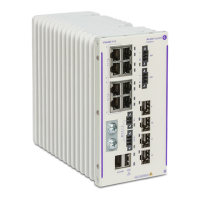Configuring Application Monitoring and Enforcement Configuring AppMon
OmniSwitch AOS Release 8 Network Configuration Guide December 2017 page 29-16
Configuring L3 Mode of Operation
To enable or disable monitoring and enforcement for IPv4 flows, IPv6 flows, or both, use the app-mon l3-
mode command. By default, monitoring and enforcement is enabled for both IPv4 and IPv6 flows.
For example, the following command enables monitoring and enforcement for IPv4 packets:
-> app-mon l3-mode ipv4 admin-state enable
The following command disables monitoring and enforcement for IPv4 packets:
-> app-mon l3-mode ipv4 admin-state disable
Configuring L4 Mode of Operation
To enable or disable monitoring and enforcement for TCP or UDP flows, use the app-mon l4-mode
command. By default, both TCP and UDP flows are processed. For example:
The following command enables monitoring and enforcement for UDP flows:
-> app-mon port 1/1/2 l4-mode udp admin-state enable
The following command disables monitoring and enforcement for UDP flows:
-> app-mon port 1/1/2 l4-mode udp admin-state disable
A specific L4 port range can be excluded from the AppMon operation using the app-mon l4port-exclude
command. The valid Exclude ID range is 1–8. The valid port range is 1–65535.
For example, to exclude TCP port 20 to port 30 from the AppMon operation, use the following command:
-> app-mon l4port-exclude range-id 5 tcp-service-port start 20 end 30
Use the no form of the app-mon l4port-exclude command to delete the range. For example,
-> no app-mon l4port-exclude range-id 6

